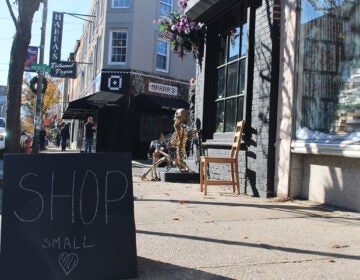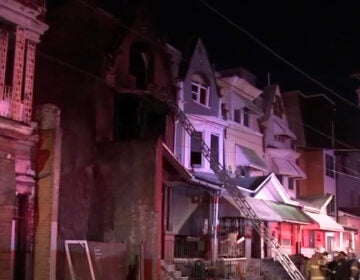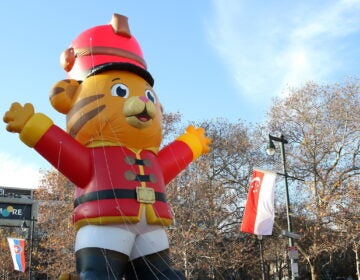For its bicentennial, the Historical Society of Pennsylvania will tell the stories of its community partners
The first exhibition, which opens Jan. 30, will be in collaboration with the Association for Public Art.
Listen 1:23
The Historical Society of Pennsylvania archives contain a large collection of Dox Thrash's WPA-era works. (Emma Lee/WHYY)
From Philly and the Pa. suburbs to South Jersey and Delaware, what would you like WHYY News to cover? Let us know!
The Historical Society of Pennsylvania turns 200 years old in 2024. To mark its bicentennial, the history archive is partnering with five Philadelphia organizations to highlight selections from its vast collection of mostly manuscripts, papers, and records.
“We have almost 22 million items in the collection,” said CEO David Brigham. “Okay, that’s cool. But what does that mean? What are they? Why do they matter?”

To answer that question, HSP identified five thematic areas to explore with its collection, each with the help of an outside non-profit:
- “Public Art in Philadelphia: A Legacy Shaped by Women” (Association for Public Art)
- “Americans and Innovation: Science, Technology, and Enterprise” (Science History Institute)
- “Pennsylvania: Crucible of the Nation,” (Independence Historical Trust)
- “America’s Promise and its Many Voices” (Taller Puertorriqueño)
- “What’s Your Story? Chronicling Families and Communities” (Genealogical Society of Pennsylvania)

“HSP has always been here for the entire community,” Brigham said. “We felt the best way to signal that was by working with organizations that have different footprints and let their audiences know we’re here.”
Each partnering organization will work with curators to present material in glass cases in the public space of HSP’s building in Center City, 1300 Locust Street, and program an event.

For example, the Independence Historical Trust, which raises capital funds for Independence National Historical Park, will showcase bygone political cartoons and political speeches that address issues still relevant now. The Science History Institute in Old City will show materials and drawings related to Philadelphia’s science and engineering innovations.
Taller Puertorriqueño, a Puerto Rican and Latino cultural center in North Philadelphia, will revive a community history initiative it started soon after its founding 50 years ago. From 1977 to 1978, Taller gathered oral histories to record the experiences of Puerto Ricans who immigrated to Philadelphia, or were the children of immigrants. It was called “Batiendo la Olla.”
“It means ‘stirring the pot,’” said executive director Nasheli Ortiz González. “You don’t know what is in the pot — only if you are stirring the pot.”

One of the unidentified interviewees was the daughter of parents who grew up in the city of Ponce in Puerto Rico, immigrating to Philadelphia in the 1940s. She recalled her family was most comfortable speaking in English at home.
She also remembered driving to the Basilica of Saints Peter and Paul to attend mass, but her mother did not like to go very often.
“She doesn’t feel right going to a temple or church and praying to saints and a priest who is just as human as I am,” she said. “She’d rather talk to God by herself.”

One of the standard interview questions in “Batiendo la Olla” was to ask whom you would call if you got into trouble with the police. Another unidentified interviewee said he would call his mother, not his father.
“Way back, the older people — my father is really rough. My father would really come down on me when it comes to something like that,” he said. “I figured my mother was softer. She would always get me out if I got into any trouble.”
“Your father would beat you up?” the interviewer asked.
“He would tear my skin off.”
Taller Puertorriqueño and the Historical Society of Pennsylvania had previously partnered on a history project. Two decades ago they collaborated on a website “Neighbors/Vecinos,” exploring the history of Puerto Ricans in Philadelphia, starting in 1815 when trade opened between Philadelphia and Puerto Rico, and exploring the role of cigar manufacturing in immigration.

González said it’s important for neighborhood-based organizations like Taller to collaborate with downtown institutions.
“Historically, BIPOC communities have created spaces to tell our story,” she said. “So it is very important, now that we already have our stories told, that we expand into white spaces and other areas that our history has not been said from our own voices.”
The first exhibition, to open Jan. 30, will be in collaboration with the Association for Public Art, which is considering commissioning a contemporary artist to create original artwork for the display. Subsequent exhibitions will rotate through HSP about every two months.
WHYY is your source for fact-based, in-depth journalism and information. As a nonprofit organization, we rely on financial support from readers like you. Please give today.





